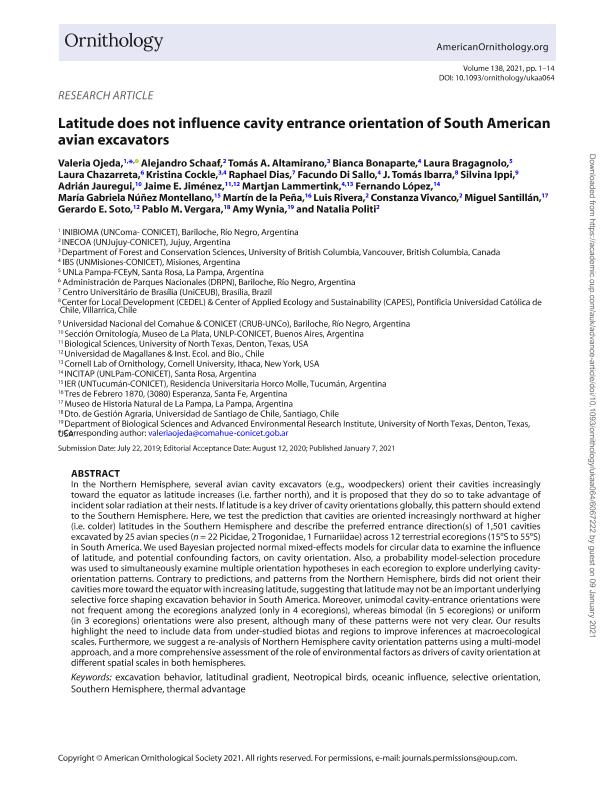Artículo
Latitude does not influence cavity entrance orientation of South American avian excavators
Ojeda, Valeria Susana ; Schaaf, Alejandro Alberto
; Schaaf, Alejandro Alberto ; Altamirano, Tatiana Edith; Bonaparte, Eugenia Bianca
; Altamirano, Tatiana Edith; Bonaparte, Eugenia Bianca ; Bragagnolo, Laura Araceli; Chazarreta, L.; Cockle, Kristina Louise
; Bragagnolo, Laura Araceli; Chazarreta, L.; Cockle, Kristina Louise ; Dias, R.; Di Sallo, Facundo Gabriel
; Dias, R.; Di Sallo, Facundo Gabriel ; Ibarra, T.; Ippi, Silvina Graciela
; Ibarra, T.; Ippi, Silvina Graciela ; Jauregui, Adrian
; Jauregui, Adrian ; Jimenez, Jaime E.; Lammertink, J. Martjan
; Jimenez, Jaime E.; Lammertink, J. Martjan ; Lopez, F.; Nuñez Montellano, Maria Gabriela
; Lopez, F.; Nuñez Montellano, Maria Gabriela ; de la Peña, Martín; Rivera, Luis Osvaldo
; de la Peña, Martín; Rivera, Luis Osvaldo ; Vivanco, Constanza Guadalupe
; Vivanco, Constanza Guadalupe ; Santillán, Miguel; Soto, G.; Vergara, P.; Politi, Natalia
; Santillán, Miguel; Soto, G.; Vergara, P.; Politi, Natalia
 ; Schaaf, Alejandro Alberto
; Schaaf, Alejandro Alberto ; Altamirano, Tatiana Edith; Bonaparte, Eugenia Bianca
; Altamirano, Tatiana Edith; Bonaparte, Eugenia Bianca ; Bragagnolo, Laura Araceli; Chazarreta, L.; Cockle, Kristina Louise
; Bragagnolo, Laura Araceli; Chazarreta, L.; Cockle, Kristina Louise ; Dias, R.; Di Sallo, Facundo Gabriel
; Dias, R.; Di Sallo, Facundo Gabriel ; Ibarra, T.; Ippi, Silvina Graciela
; Ibarra, T.; Ippi, Silvina Graciela ; Jauregui, Adrian
; Jauregui, Adrian ; Jimenez, Jaime E.; Lammertink, J. Martjan
; Jimenez, Jaime E.; Lammertink, J. Martjan ; Lopez, F.; Nuñez Montellano, Maria Gabriela
; Lopez, F.; Nuñez Montellano, Maria Gabriela ; de la Peña, Martín; Rivera, Luis Osvaldo
; de la Peña, Martín; Rivera, Luis Osvaldo ; Vivanco, Constanza Guadalupe
; Vivanco, Constanza Guadalupe ; Santillán, Miguel; Soto, G.; Vergara, P.; Politi, Natalia
; Santillán, Miguel; Soto, G.; Vergara, P.; Politi, Natalia
Fecha de publicación:
10/2020
Editorial:
American Ornithologists' Union
Revista:
Auk
ISSN:
0004-8038
Idioma:
Inglés
Tipo de recurso:
Artículo publicado
Clasificación temática:
Resumen
In the Northern Hemisphere, several avian cavity excavators (e.g., woodpeckers) orient their cavities increasingly toward the equator as latitude increases (i.e., farther north), and it is proposed that they do so to take advantage of incident solar radiation at their nests. If latitude is a key driver of cavity orientations globally, this pattern should extend to the Southern Hemisphere. Here, we test the prediction that cavities are oriented increasingly northward at higher (i.e., colder) latitudes in the Southern Hemisphere and describe the preferred entrance direction(s) of 1501 cavities excavated by 25 avian species (n = 22 Picidae, 2 Trogonidae, 1 Furnariidae) across 12 terrestrial ecoregions (15°S ? 55°S) in South America. We used Bayesian projected normal mixed-effects models for circular data to examine the influence of latitude, and potential confounding factors, on cavity orientation. Also, a probability model selection procedure was used to simultaneously examine multiple orientation hypotheses in each ecoregion, to explore underlying cavity-orientation patterns. Contrary to predictions, and patterns from the Northern Hemisphere, birds did not orient their cavities more toward the equator with increasing latitude, suggesting that latitude may not be an important underlying selective force shaping excavation behavior in South America. Moreover, unimodal cavity-entrance orientations were not frequent among the ecoregions analyzed (infour ecoregions), whereas bimodal (in five ecoregions) or uniform (in three ecoregions) werealso common, although many of these patterns were not very sharp. Our results highlight the need to include data from under-studied biotas and regions to improve inferences at macroecology scales. Furthermore, we suggest a re-analysis of Northern Hemisphere cavity orientation patterns using a multimodel approach, and a more comprehensive assessment of the role of environmental factors as drivers of cavity orientation at different spatial scales in both hemispheres.
Archivos asociados
Licencia
Identificadores
Colecciones
Articulos(CCT - LA PLATA)
Articulos de CTRO.CIENTIFICO TECNOL.CONICET - LA PLATA
Articulos de CTRO.CIENTIFICO TECNOL.CONICET - LA PLATA
Articulos(CCT - PATAGONIA NORTE)
Articulos de CTRO.CIENTIFICO TECNOL.CONICET - PATAGONIA NORTE
Articulos de CTRO.CIENTIFICO TECNOL.CONICET - PATAGONIA NORTE
Articulos(IBS)
Articulos de INSTITUTO DE BIOLOGIA SUBTROPICAL
Articulos de INSTITUTO DE BIOLOGIA SUBTROPICAL
Articulos(IER)
Articulos de INSTITUTO DE ECOLOGIA REGIONAL
Articulos de INSTITUTO DE ECOLOGIA REGIONAL
Articulos(INCITAP)
Articulos de INST.D/CS D/L/TIERRA Y AMBIENTALES D/L/PAMPA
Articulos de INST.D/CS D/L/TIERRA Y AMBIENTALES D/L/PAMPA
Articulos(INECOA)
Articulos de INSTITUTO DE ECORREGIONES ANDINAS
Articulos de INSTITUTO DE ECORREGIONES ANDINAS
Articulos(INIBIOMA)
Articulos de INST. DE INVEST.EN BIODIVERSIDAD Y MEDIOAMBIENTE
Articulos de INST. DE INVEST.EN BIODIVERSIDAD Y MEDIOAMBIENTE
Citación
Ojeda, Valeria Susana; Schaaf, Alejandro Alberto; Altamirano, Tatiana Edith; Bonaparte, Eugenia Bianca; Bragagnolo, Laura Araceli; et al.; Latitude does not influence cavity entrance orientation of South American avian excavators; American Ornithologists' Union; Auk; 138; 4; 10-2020; 1-14
Compartir
Altmétricas



